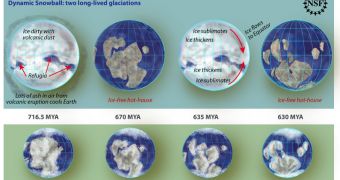For many years, a part of the international scientific community has been arguing that, at one point in time, the extent of sea-based ice caps must have reached all the way to the Equator. As more studies on this were conducted, they even managed to establish a time line of sorts, but failed to pinpoint the exact date, or period, when this happened. Now, a new investigation by a team of geologists comes to do just that. The group's main finding is that the snowball Earth indeed occurred some 716.5 million years ago.
The new work was conducted on a wide array of tropical rocks, which currently endure in countries such as Canada. As the initial, larger continent split into several, smaller ones, the landmasses here wound up in all sorts of places, not the least weird of which is Canada. Though it may seem irrelevant, the geology team behind this study says that the records these rocks contain are absolutely essential for understanding what our climate looked like. The investigation was led by a group of experts from the Harvard University, who conducted this work with funding from the National Science Foundation (NSF). Details appear in this week's issue of the esteemed publication Science.
“This is the first time that the Sturtian glaciation has been shown to have occurred at tropical latitudes, providing direct evidence that this particular glaciation was a 'snowball Earth' event. Our data also suggest that the Sturtian glaciation lasted a minimum of five million years,” says Harvard University geologist and lead study author, Francis Macdonald. “Ice may have covered the entire planet then, turning it into a 'snowball Earth',” adds the program director of the NSF Division of Earth Sciences, Enriqueta Barrera. The expert adds that this event was one of the two biggest glaciations known to have occurred on our planet.
“The fossil record suggests that all of the major eukaryotic groups, with the possible exception of animals, existed before the Sturtian glaciation. The questions that arise from this are: If a snowball Earth existed, how did these eukaryotes survive? Did the Sturtian snowball Earth stimulate evolution and the origin of animals? From an evolutionary perspective, it's not always a bad thing for life on Earth to face severe stress,” Macdonald adds. “Climate modeling has long predicted that if sea ice were ever to develop within 30 degrees latitude of the equator, the whole ocean would rapidly freeze over. So our result implies quite strongly that ice would have been found at all latitudes during the Sturtian glaciation,” he concludes.

 14 DAY TRIAL //
14 DAY TRIAL //